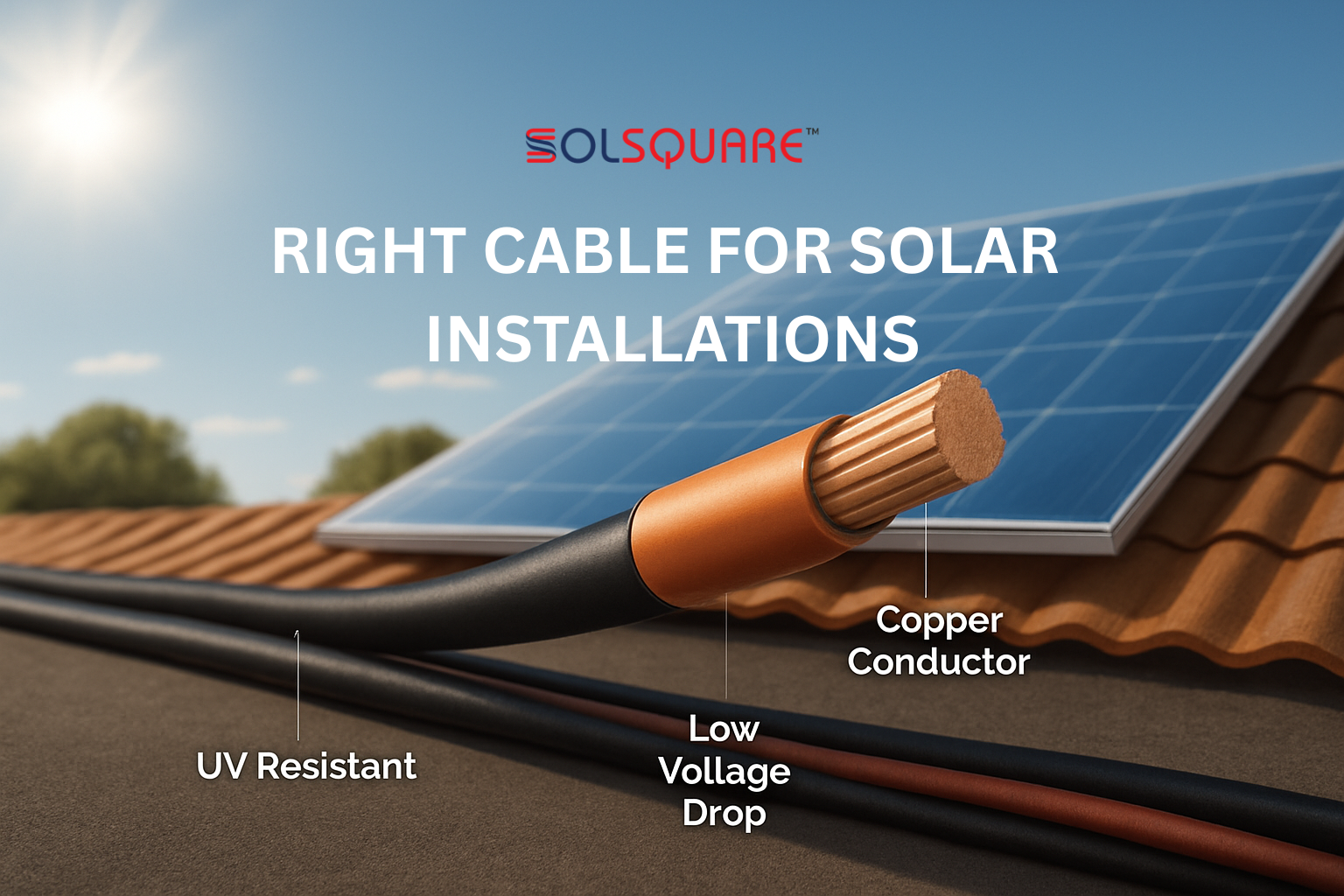How to Choose the Right Cable for Rooftop Solar Installations
In the case of rooftop solar installation, there is a focus mainly on solar panels, inverters and the batteries. The important yet underestimated part is the cable.

The use of the appropriate kind of cable provides safety, efficiency, and reliability of your solar power system in the long run. Poor choice of cable may result in wastage of energy, overheating and even fire.
In this blog, we will walk you through the major considerations on choosing cables to install rooftop solar systems among them; type, size of the cable, insulation, certificates and installation guidelines. This guide will help solar installers, electrical engineers, or homeowners intending to go solar make an informed choice.
Why Cable Selection Matters in Solar Systems
The cables are the veins of the solar energy system to ensure the power runs between the solar panels, inverter and battery and the main connection to the grid. Low quality cabling; Low-sized cable can lead to:
- Voltage drop and reduced efficiency
- Overheating and damage to equipment
- Increased fire risk
- Shortened system lifespan
Because rooftop systems are fully subjected to outdoor elements, solar cables must be able to resist weather conditions, extreme flexing capabilities, UV light protection, and endurance.
Important Considerations to make with regards to the Selection of Cables
1. Cable Type: DC vs AC
Solar systems use both DC and AC cables:
| Cable Type | Usage in Solar System | Typical Path |
|---|---|---|
| DC Cable | Between panels and inverter | Panel → Combiner Box → Inverter |
| AC Cable | From inverter to load/grid | Inverter → Distribution Board/Grid |
DC Cables must handle high currents and constant voltage.
AC Cables are used after the inverter, carrying alternating current to the grid or load.
Ensure the cable is designed specifically for DC usage if connecting panels. Generic electrical wires may not perform safely or efficiently in solar DC circuits.
2. Cable Size
Size of the cable influences voltage drop, and amp rating. A lower voltage drop means higher efficiency.
Use this table as a basic reference for typical rooftop systems:
| System Size | Cable Size (mm²) | Approx. Current | Max Distance (one-way) |
|---|---|---|---|
| 1 kW | 2.5 mm² | 8-10 A | Up to 10 m |
| 2-3 kW | 4 mm² | 15-20 A | Up to 15 m |
| 3-5 kW | 6 mm² | 25-32 A | Up to 20 m |
| 5+ kW | 10 mm² | 40-50 A | Up to 25 m |
Use of a voltage drop calculator or always consult an engineer to gather the most appropriate size as per system layout.
3. UV Resistance & Insulating Material
Solar cables are subjected to exposure of water, sun, temperature variation and pollution. These conditions must not suffer gradual destruction by the insulation.
The usual insulating material is XLPE (Cross-linked Polyethylene) and EVA.
You should identify cables that have a UV-resistant, weatherproof, and ozone-resistant mark.
Tinned copper cores are preferred over plain copper for corrosion resistance.
4. Cable Standards and Certifications
Choose cables certified for solar use. Look for compliance with:
- TUV Rheinland – Commonly used for PV cables in Europe/India
- IEC 62930 – International standard for photovoltaic cables
- UL 4703 – US standard for PV Wire
- IS 694 or IS7098 – India – standards for general-purpose wires (less preferred for solar)
Avoid using uncertified or generic electrical wires as they tend to degrade quicker and void your solar warranty.
5. Single-Core vs Multi-Core
Single-core cables are generally easier to work with for most rooftop solar systems, due to simpler current pathways, but also better cooling pathways.
Multi-core cables can be used in short runs or compact installations but may trap heat and are harder to route.
6. Color Coding
- Red (+) for positive DC
- Black (-) for negative DC
- Green or yellow/green for grounding
- Blue or brown for AC phases
7. Routing, and Flexibility
Solar cables have to be of manageable grade so they can be adapted within the bends or conduits or rooftop mountings without breaking or cracking.
Flexibility, find stranded copper conductors of Class 5 or 6.
Rigid wires are harder to install and more prone to damage in rooftop environments.
8. Fire and Temperature Ratings
Choose cables with high flame-retardant ratings and low smoke emission.
Cables should operate between -40°C to +90°C or higher.
Some cables come with halogen-free insulation for added fire safety in residential buildings.
9. Length and Voltage drop Consideration
Be sure to measure the distance that the cable will run and leave some slack. The amount of voltage drop in a DC circuit should generally be less than 3% to ensure efficiency of such systems.
You may apply the formula:
VD = (2L * I * R) / 1000
10. Price vs Performance
While cheaper wires may seem like a good deal, premium solar cables offer:
- Longer life (25+ years)
- Less energy loss
- Better safety
- Reduced maintenance
Conclusion
Choosing the right cable to integrate to your rooftop solar installations does not only amount to purchasing wire. It is also performance, safety and life of your entire system. Using a quality cable prevents losses, heating and assures you that your investment in solar energy will pay back in full as many decades as possible.
In short, when next you consider laying out a roof solar installation keep in mind that: Proper cable size, DC/AC type compatibility, Weather resistance, Certified standards. Your solar system is only as strong as its weakest component—make sure the cable isn’t the one.